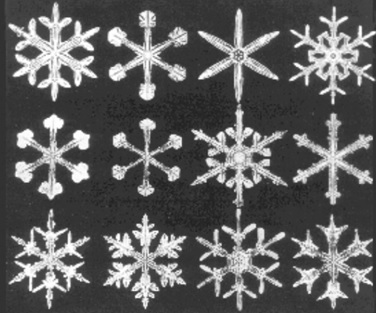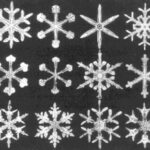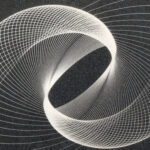I have enjoyed the frequent snowfalls this winter in the mountains of Colorado. I admire both the enchanting beauty of the falling snow and the majesty of the snow-covered mountains. I also recently came across this amazing article in Smithsonian Magazine on the Highest Resolution Photos Ever Taken of Snowflakes. It details the serious challenges to snowflake photography, and the great lengths committed snowflake photographers take to get their shots. These images, and the many others to be found on the internet, are stunningly beautiful and remarkably complex.
As we all know, snowflakes are not only beautiful, they are also unique – no two are ever the same. Almost all snowflakes, however, are built on a hexagonal pattern (six sides) due to the subtle way that water (H2O), with two hydrogen and one oxygen molecules bonded together by their respective charges, tends to crystallize. These crystals can grow to be incredibly complex branching fractal structures built on that hexagonal frame. They may not come in spirals, but it is still worth featuring in Spiral Inquiry.
Recently, on one of our hikes up the snowy hills, I wondered how many snowflakes it takes to make this glorious white landscape. It is a big number, and difficult to estimate, but I wanted to have some idea of the range of estimates. I found a source, the Center of Science and Industry (COSI) in Columbus, Ohio, willing to estimate the number of snowflakes, on average, in a cubic inch. They assume a size of about 1/10th of an inch per snowflake, which means one layer would be 10 along each side of the cubic inch, or 10×10 or 100 snowflakes for each layer. They also speculate that it would take 10 layers to fill the cube. Thus, their total estimate is 1,000. This would require that the snowflakes all land in a random or “fluffy” manner, more like a cube than the flat structure in which they are constructed. It also ignores the problem of snow packing that occurs after the snow falls but prior to the physical measurement of a snowfall event. So my guess is the COSI estimate is too low, perhaps by an order of magnitude. So I’d guess the number could be, perhaps, 10,000 per cubic inch. To ramp that up to cubic feet, we multiply by 1,728 (12x12x12), for a total of 17.28 million snowflakes per cubic foot. This seems to make sense.
The next step is to calculate the annual depth of snowfall and the area it falls on. It is helpful that the nearby ski area of Vail Colorado makes those numbers available. They estimate an average snowfall of 252 inches, or exactly 21 feet, on a total terrain of 5,289 acres. One acre has 43,560 square feet, so the total terrain is some 230.4 million square feet. Multiply that by 21 feet and we get a total snowfall of 4.84 billion cubic feet, falling on the slopes of Vail in an average year. This is a number I can grasp – a billion is big, but it is possible to imagine.
So now, to get the snowflake count, we just multiply 4.84 billion cubic feet by 17.28 million snowflakes per cubic foot. That turns out to be 83.6 quadrillion (or million billions) snowflakes falling on Vail Colorado in an average winter. Truly hard to grasp.
But it doesn’t end there.
What about the Rocky Mountains in total? The Rockies (in the US and Canada) cover about 300,000 square miles. There are 640 acres in a square mile, so we can convert to acres = 192 million acres. Ignoring the fact that Vail probably gets more than the average mountain, we can estimate a total snowfall of about 4 billion acre feet of snow, or about 175 Trillion cubic feet of snow. Multiplying by the estimated number of snowflakes per cubic foot we get the staggering number of just over 3 sextillion (or 3.0 x 1021). The total is more than a billion trillions and, to be honest, it is a number I really cannot make sense of.
Curiously, this number is not far from what Dr. Jason Marshall (aka The Math Dude) has calculated for the number of grains of sand on the beaches of the world – about 5 sextillion. (ref: Are there more grains of sand or stars in the sky). So you could say there are about as many snowflakes each year in the Rockies as there are grains of sand on the world’s beaches, more or less….
But this is still less than the number of stars in the universe, which are estimated at about 200 sextillion. That is a lot of stars. The universe is very big.
Fraser Caine (Universe Today) takes this comparison one step further. How does this compare with the number of atoms in the universe? Atoms are very small! According to his calculations, 10 sextillion atoms is about four times smaller than a dust mite (which is much smaller than a grain of sand). So he concludes: a single grain of sand has more atoms than there are stars in the Universe.
How many atoms are there in the universe? Calculations range from 1078 to 1086 (source: Science ABC). Those are big numbers. They really don’t have names.
So?…
They are still smaller than a single google (the number, not the company) at 10100. And of course, it is way smaller than a google-plex (10google). It is a fact – numbers never end. As hard as we try, we will never get to infinity.
















